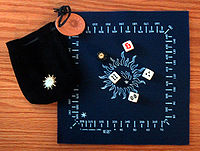




Cosmic Wimpout set, including dice and a dice bag
|
|
| Genre(s) | Dice Rolling |
|---|---|
| Players | 2 and up |
| Age range | 7 and up |
| Playing time | 20 minutes |
| Random chance | High (Dice) |
| Skill(s) required | Arithmetic, Risk Management |
Cosmic Wimpout is a dice game produced by C3, Inc in 1976. It is similar to 1000/5000/10000, Farkle, Greed, Hot Dice, Squelch, Zilch, Zonk, or Darsh to name but a few. The game is played with five custom dice, and may use a combination score board and rolling surface, in the form of a piece of cloth or felt available in various colors and designs. Players supply their own game piece for score keeping.
The game of Cosmic Wimpout has often been associated with the Berkeley area, the Grateful Dead, and other free-form subcultures. An annual tournament takes place at the Green River Festival in Greenfield, Massachusetts.
The five Cosmic Wimpout dice are referred to as "cubes". Four of the cubes have face values of "two swirls", "three triangular glyphs", "four lightning bolts", "the number 5", "six stars" and "the number 10" - the fifth cube, often a different colour, has a single "flaming sun" icon in place of the triangular glyphs. The general rules for the game have evolved since its inception and there have been various minor modifications made to the colors and patterns of the face designs on the cubes.
The game is played by rolling all five cubes and adding up the player's score. Any fives or tens rolled are worth that amount. Rolling three of a kind of any number, or a pair and a "flaming sun", is a "flash" - the swirls are twos, the triangular glyphs are threes, the lightning bolts are fours, and the stars are sixes. A flash scores ten times the number of one of the dice in the flash. For example, rolling three twos is worth 20 points, and rolling three fives is worth fifty. When a player rolls scoring dice, they must set them aside, and may choose to either keep the points they have, or to roll the non scoring dice and try for more points.
There are three exceptions to this general guideline, which force rolls in certain cases:
If a player rolls the dice and no points at all are scored, that player has "wimped out". If the player rolled all five cubes and scores no points, this is a "train wreck". In any case, the player loses all points gained in that round. Herein lies most of the game's strategy: if a player keeps the points they get, those points are "safe" for the remainder of the game, and the player's score cannot drop below that value, house rules notwithstanding.
In his 2007 essay on the game, game designer Andrew Looney described Cosmic Wimpout as the "single most influential game I've ever played" and that the game "has a clean, elegant set of rules that allows losing players to feel they still have a chance at a come-from-behind victory." Looney cites Cosmic Wimpout's influence from the French dice game Dix Mille ("Ten Thousand") and names other variations of the game including Bupkis, Greed, Farkle, and Zonk.
Cosmic Wimpout was created with the ability to modify or add additional rules while playing, known as the Guiding Light, given the consensus of all of the players. For example, some players use the Full House rule, which states that if a player rolls a flash, and rolls a pair with your remaining two die, they must roll again.
Another variation is the Cosmic Sampler variation, which featured in an electronic version for the Palm. A Sampler is when none of the dice on any roll match, similar to a large straight in Yahtzee. Scoring for a Sampler is 25 points.
Cosmic Wimpout is featured in the independent film Goodbye World